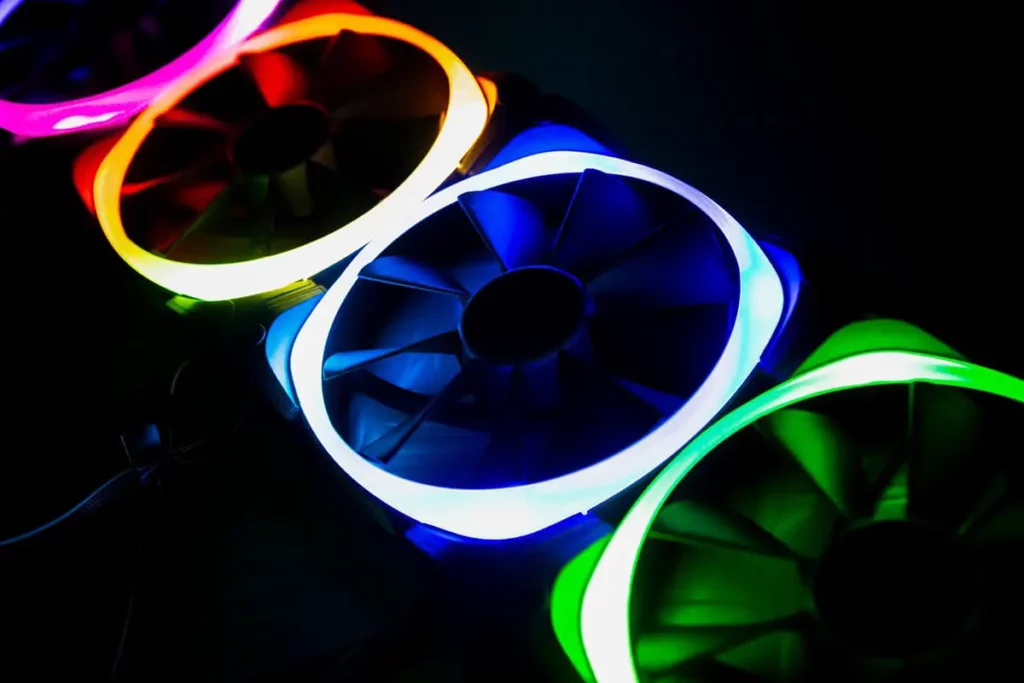With the advancement of technology, new materials are being used to manufacture different kinds of goods. And since RGB fans are a relatively recent innovation, it’s only natural that there are some concerns over the longevity of these products. So, how long do RGB fans last?
RGB fans can last as long as 5-10 years, or as long as the lifespan of its parts. Mechanical parts wear down due to constant usage, but this typically takes years before having a drastic impact on performance. Keep in mind, longevity can vary from product to product.
The rest of the article will discuss why RGB fans last for so long and how you can improve the longevity of your cooling components. We’ll also list down some of the best RGB fans you can find on the market.
Reasons Why RGB Fans Last for So Long
RGB fans, like many other PC components, are long-lasting thanks to the power of ball-bearings.
Ball-bearing is the most commonly used type of bearing to support linear motion and rotation. The secret behind the longevity of ball-bearings lies in their ability to move without friction.
A thin layer of lubricant reduces friction between the balls and the cage, thereby minimizing wear and tear. As long as the operating environment remains in ideal condition (minimal dust buildup, proper temperature, and good fluid dynamics), ball-bearings can last for years on end.
It’s important to note that the LED lighting in RGB fans has no impact on the product’s lifespan. LED lights will always outlive ball-bearings; a typical LED light can last for 100,000 hours.
RGB fans have a life expectancy of around 30,000-50,000 hours. That’s 3-6 years of constant cooling. Most RGB fans can exceed their shelf life and operate for several years – provided that you frequently remove dust buildup and apply maintenance when necessary.
You shouldn’t really worry about the shelf life of such products. The only way an RGB fan would actually “die” before its expected expiry date would be through mechanical failure or accidental wire damage. The ball-bearings within an RGB fan can also wear out after prolonged usage.
As a general rule of thumb, you should replace your fan once it starts making noises. A drop in rotational speed can also indicate a dying fan.
Factors that Affect Longevity
The longevity of an RGB fan directly depends on the condition of the ball bearings. This can be affected in two ways; by mechanical failures or by changes in the lubricant.
Mechanical failure can occur due to a number of reasons:
- Damage to internal wiring
- Debris blocking the pathways inside ball-bearing
- Misalignment of spheres
- Electrical damage
- Overheating
80% of bearing failures are attributed to changes in lubricant. Subjecting the ball-bearings to high temperatures can result in changes to lubricant viscosity. Dust also plays a significant role in degrading lubricant quality.
How To Improve Longevity of RGB Fans
You can prolong the lifespan of your RGB fans by:
- Regularly cleaning your PC from excess dust buildup. Be sure to clean out dust from the rotor and fan blades. Cleaning once a month should be enough to keep your PC dust-free.
- Picking a location where it’s not too dusty and humid. Avoid placing your desktop PC on a thick carpet. This will prevent excess dest accumulation and overheating.
- Ensuring that airflow isn’t restricted. Poor case design and excess dust can restrict airflow. This, in turn, can damage ball-bearings and massively reduce your fan’s life expectancy.
- Only purchasing high-quality RGB fans. Cheap RGB fans don’t last for too long due to poor bearing design. The more expensive ones are less likely to break down because they have better motors and other internal components that last quite a bit longer. If you buy a cheaper model, then expect to replace it sooner.
Best Long-Lasting RGB Fans on the Market
| Model | Shelf Life (hrs) | Pros | Cons |
| Corsair LL Series LL120 | 200,000 | Impressive RGB lighting with a variety of effectsProduces minimal sound at maximum speedExceptional build quality, very durable | Requires a controller to adjust the fan speedNot the best option when it comes to cooling |
| Corsair ML120 Pro | 200,000 | Solid performance with minimal noiseVery good at coolingVery flexible fan controls | The RGB lighting is a bit dimThe fan starts making noise at maximum speed, |
| Cooler Master Sickleflow 120 V2 ARGB White Edition | 160,000 | Exceptional cooling performanceNot too expensive considering its features | Limited lighting options ARGB isn’t that impressive |
| Thermaltake Riing Trio 12 | 120,000 | The RGB lighting is bright and provides a plethora of effectsRGB software to adjust the lightingProduces minimal noise even at maximum speed | A bit too expensive for casual usersDifficult to assemble and install |
| Fractal Design Dynamic X2 GP-12 White Edition | 100,000 | Very budget-friendly and affordable for most usersPowerful cooling and solid performanceGreat build quality | Simple basic design with no lightning options availablePoor quality wiring |
| Fractal Design Prisma Al-14 PWM 140mm | 100,000 | Minimal noise at low RPMsBeautiful RGB lighting with various combinationsEasy to use | Can be a bit too large for some casesThe PWM wiring is too short and may require use of an extension wire |
| NZXT Aer RGB 2 120mm | 60,000 | Advanced lighting customizationExtremely durable thanks to premium quality materialsFluid dynamic ball-bearings for minimal noise | Shelf-life isn’t that impressive as other RGB fansDifficult to install the fan due to USB 2.0 requirementsUnnecessary additional wiring |
Conclusion
RGB fans are a great addition to any desktop PC. Their ability to change colors makes them appealing to the eyes. They give your fan an added touch that can make your build look professional. However, it’s essential to make sure you purchase quality products if you want them to last for several years.
By following these simple guidelines, you can help make your RGB fan last as long as possible. I hope you’ve found these tips helpful!







